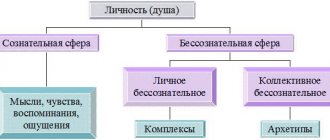Opinions of domestic and foreign authors on the nature of self-awareness
At the present stage of development of psychology, the question of self-awareness attracts the attention of many domestic and foreign researchers. Not all authors use the terms “self-perception”; the terms “self-esteem”, “cognitive component of self-awareness”, “self-awareness”, “self-esteem”, etc. are also used to designate this content area.
The concept of self-awareness is the totality of all a person’s perceptions about himself, associated with their assessment. The descriptive component of self-perception is the self-image or self-image; the component relating to one's attitude toward oneself or one's individual characteristics is self-esteem or sense of self. The concept of self-awareness determines not only what a person is, but also what he thinks about himself, how he sees his activities and opportunities for future development.
As Burns points out, the separation of descriptive and evaluative components allows one to view the sense of self as a set of self-directed attitudes. In relation to self-perception, the three main elements of attitude can be defined as follows:
- the cognitive component of the relationship—self-perception—is a person’s idea of himself.
- the affective component - self-esteem - is an affective assessment of this idea, which can be of varying intensity, since some features of self-awareness can evoke more or less strong emotions in terms of their acceptance or disapproval.
- potential behavioral responses, e.g. specific actions that can be caused by self-image and self-concept. .
Personal self-awareness can be represented as a cognitive system that performs the function of regulating behavior in appropriate conditions. It includes two main subsystems: personal identity and social identity. Personal identity means self-determination in terms of physical, intellectual and moral traits of an individual. Social identity consists of individual identification and is determined by the individual's belonging to various social categories: Race, nationality, class, gender, etc. Along with personal identity, social identity turns out to be an important regulator of self-esteem and social behavior.
Like all categorizations, self-conscious categories are based on the perception of intragroup similarities and intergroup differences. They are organized in a hierarchical system and exist at different levels of abstraction: The greater the range of values covered by a category, the higher the level of abstraction, and each category is contained within another category unless it is the highest.
I.S. Kon, revealing the concept of “I” as an actively creative, integrative principle that allows a person not only to be aware of himself, but also to consciously direct and regulate his activities, notes the duality of this concept, self-consciousness includes two “I”:
- “I” as a subject of thought, a reflexive “I” - an active, acting, subjective, existential “I” or “I”;
- “I” as an object of perception and internal sensation is an objective, reflective, phenomenal, categorical “I” or image of “me”, “concept of me”, “I-concept”.
The reflective “I” is a kind of cognitive scheme underlying the implicit theory of personality, against which the individual structures his social perception and the perception of other people. In the psychological order of self-representation of the subject and his dispositions, the main role is played by higher dispositional formations - in particular, the system of value orientations.
I.S. Cohn raises the question of whether an individual can adequately perceive and evaluate himself in connection with the problem of the relationship between the main functions of self-consciousness - the regulatory-organizing function and the function of self-defense. In order to successfully control one’s own behavior, the subject must have sufficient information both about the environment and about the state and characteristics of one’s own personality. In contrast, the ego's defensive function is primarily concerned with maintaining self-esteem and stability of self-esteem, even at the cost of distorting information. Depending on this, the same subject can make both appropriate and incorrect self-assessments. The low self-esteem of a neurotic is a motive and, at the same time, a self-justification for giving up activities, and self-criticism of a creative person is an incentive for self-improvement and overcoming new milestones.
The structure of the phenomenal self depends on the nature of the processes of self-knowledge that lead to it. In turn, the processes of self-knowledge are involved in the processes of communication between a person and other people, in the processes of the subject’s activity. Analysis of the structure of the subject’s self-perception, self-education and self-esteem depends on how these processes are implemented and, accordingly, on the subject’s self-perception in the study.
Recognition and acceptance of all aspects of one's true self, in contrast to “conditional self-acceptance,” provides for an integrated self-esteem, affirms the “I” as the measure of the “I” and its position in the space of life. Internal dialogue here performs the functions of clarifying and affirming self-identification, and its specific forms, reasons and motives indicate the degree of harmony - contradiction, maturity of self-awareness. Psychological conflict becomes an obstacle to personal growth and self-realization when interaction, dialogue of Self-images, “split” are interrupted, each of which, as an essential part of the Self-concept, strives to “affirm”, “speak”, “be heard”, but not accepted, rejected, or defensively reconstituted as one's own. Conflict can arise between any dichotomous, opposing aspects of personality.
The attitude of the individual towards himself, which arises as a result of the activity of self-consciousness, is at the same time one of its fundamental characteristics, which significantly influences the formation of an essential structure and the manifestation of the entire system of other mental characteristics of the individual. A proper conscious and consistent emotionally assessed attitude of a person towards himself is a central element of his internal mental world, which creates its unity and integrity and coordinates and organizes the internal values of the person that he assumes in relation to himself.
Thus, self-perception is a person’s holistic idea of himself as an individual, as a biological organism, as a member of society, as an employee, as a professional, etc. The concept of self functions as an attitude towards oneself and includes the following components:
- cognitive - an image of one’s qualities, abilities, appearance, social significance, etc. ;
- emotional - self-esteem, self-love, self-deprecation, etc.;
- evaluative will - the desire to increase self-esteem, gain respect, etc.
In the early decades of the twentieth century, scholars such as C. Cooley and J. Mead began to study “self-concept” from a sociological perspective. This trend has become known as “social interaction.” But long before that, in 1752, A. Smith, a representative of the Scottish school of moral philosophy, wrote that a person’s attitude towards himself, his self-esteem depend on other people, and if you look at them and rely on their attitude, you can see your own merits and demerits, as if in a mirror. And we judge ourselves and our behavior just as much as we think they judge us.
Later, K. Cooley and J. Mead developed the theory of the “mirror self” and substantiated their position by arguing that it is society that determines both the development and content of the “self-concept”. Later, followers of symbolic interaction, such as M. Kuhn, A. Rose, Lévi-Strauss, T. Shibutani and others, developed the problems raised by these scientists. D. Schuper, R. Equier, J. Bugenthal, as the authors of the individual approach, put the opposite emphasis - they put the internal factors of the formation of the “self-concept” at the basis of their theory.
Another approach to the study of the “I” is offered by the psychoanalytic school. In his epigenetic theory, E. Erikson, based on the views of Z. Freud, considers the “concept of ego” through the prism of ego-identity. According to him, the nature of self-identity is related to the characteristics of the cultural environment and the abilities of the individual. His theory describes eight stages of personality development that are directly related to changes in ego identity, and identifies crises that arise when resolving internal conflicts characteristic of different ages of development. Erickson focuses specifically on adolescents and adolescents. In contrast to symbolic interaction, he writes about the mechanism of formation of self-awareness as an unconscious process.
C. Rogers' client-centered therapy focuses on the conflict between the relationship of the personal self, formed under the influence of other people, and the individual's immediate experience. This, in his opinion, is the root of maladjustment. One of the postulates of his theory is to consider the deep layers of the human psyche as socialized and positively oriented. The author distinguishes between the terms “I” and “self-concept”. Here, the “I” is the result of directly experiencing one’s reality in life, while the “I-concept” is a stable formation that develops throughout life and is influenced by factors such as social norms and other people’s reactions to a person’s behavior .
J. Kelly's theory of personal constructs is associated with the study of oneself as an empirical system. It is based on the concept of a construct, which is a unit of experience. A construct is how a person interprets reality. Thus, human experience is shaped by a system of personal constructs.
One of the directions, formed under the influence of the ideas of K. Rogers, whose representatives W.B. Swann and S.S.B. Swann and S.S. Swann still include a number of works aimed at studying problems such as the organizing role of “self-concept” in communication, the structuring of cognitive processes and mechanisms for maintaining the existing “self-concept”. V.B. Swan, the author of verification theory, argues that the “self-concept” needs confirmation by other people, which makes the world more predictable and controllable and is the basis for close relationships and activities. S. Nevertheless, the author of the concept of self-affirmation identifies the motive of self-affirmation as one of the determining factors of personal behavior.
Research by a number of scientists, such as R.A. Neumayer, M.D. Berzonsky, R.M. Perkins, J. Adams-Weber and others, traced the influence of the “I-concept” on various characteristics of cognitive processes, such as memory organization, complexity of cognition, as well as on the structure of the external image and various personality traits. In L. Festinger, according to the theory of cognitive dissonance, a person achieves internal cognitive consistency in the process of self-knowledge, exploring himself. The theory of congruence by K. Osgurd and P. Tannenbaum explores the connection that arises when comparing two objects - information and communication - within the framework of the cognitive structure of the individual.
Among the researchers of “self-concept” one cannot fail to mention R. Burns. His theory is based on the views of such scientists as E. Erikson, J. Mead, K. Rogers. In Burns, “self-awareness” is associated with self-esteem as a set of attitudes “about oneself” and is the sum of all a person’s ideas about himself. In his opinion, this follows from the separation of descriptive and evaluative components. The descriptive component of “self-knowledge” is what the author calls self-image or self-image. Component relating to attitude towards oneself or one's individual characteristics, self-esteem or self-acceptance. He writes that the “concept of self” determines not only what a person is, but also what he thinks about himself, how he sees his activities and the possibilities of his future development.
Despite the fact that most researchers identify many images in the structure of the “I,” the greatest differentiation is found in the work of the American psychologist M. Rosenberg. The most important among them are the “real self”, “real self”, “dynamic self”, “possible or future self”, “idealized self”, as well as a number of “imagined selves”. The differences between the material self and the identical self can be found in the works of Z. Freud, K. Lewin, K. Rogers and others.
Viewing a person's life as a script formed the basis of scenario analysis developed within the framework of the Bernean interaction. This approach was used by such researchers as A. Schutzenberg, I. Hoffman, and representatives of narrative psychology. Of these, the most developed is J. Hoffman's theory of oneself as a plot. In the theory of the roles of social drama, I. Hoffman compares theatrical productions with real life. According to him, personality performs various roles to achieve communication goals.
In Russian psychology, the “concept of self” was considered mainly in the context of the study of self-awareness. This problem was solved by V.V. Stolin, T. Shibutani, A. A. Nalachzhanyan, E. T. Sokolova, S. R. Panteleev, N. I. Sarzhve - Ladze.
Many authors divide the variety of theories in the study of the “I” into structuralist and functionalist. The first group includes all theories that consider “I” as a structure that performs certain functions. The second group includes all theories that study themselves as part of an extrasensory experience and explore the structure of this experience. According to the first approach, the Self is complex and multidimensional; according to the second approach, it is unitary and holistic.
An analysis of the scientific literature has shown that in the study of “self-awareness” there are many approaches that consider the problem in close connection with the individual’s self-awareness, from different theoretical positions that are interrelated and sometimes contradict each other.
Essence of Self - Concepts
“The self-concept is the individual’s perception of himself and his thoughts about himself, which are collected together and constitute a kind of control center within the person.
What does the term “I-concept” mean, what is its real psychological meaning? In literature, both Russian and foreign, there is no single interpretation, and self-awareness is closest to meaning. However, self-concept is a less neutral term that includes the evaluative aspect of self-awareness. This is a dynamic system of human self-perception, which includes the perception of one’s physical, intellectual and other qualities and self-esteem, as well as the subjective perception of external factors influencing the personality. A person’s self-concept arises in the process of social interaction as an inevitable and always unique result of psychological development, as a relatively stable and at the same time psychological acquisition subject to internal changes and fluctuations. It indelibly shapes all manifestations of a person’s life, from childhood to adulthood.
Self-concept is an important factor in the organization of an individual's psyche and behavior, since it determines the interpretation of experience and serves as a source of expectations for the individual.
The initial dependence of the self-concept on external influences is undeniable, but later it plays an independent role in the life of every person. The surrounding world, ideas about other people are perceived through the prism of the self-concept, which is formed in the process of socialization and education, but also has certain somatic, individual-natural determinants. The needs of a developing personality change with age. In them and through them, a person manifests himself, and accordingly his self-perception is destroyed. In turn, this also serves as meaningful feedback for them. Unlike situational ideas about oneself (how a person sees and feels at a particular moment in time), the self-concept creates in a person a feeling of constant certainty and self-identity. In general, this is a dialectic of the formation and manifestation of contradictory, always incomplete self-concepts - the self-concept with its intellectual, emotional and behavioral components.
Psychologists distinguish two components of human personality, that is, selfhood, namely: self-concept (thoughts about oneself) and self-esteem (feelings about oneself and evaluation of oneself). Sometimes the two components—thoughts about oneself and evaluations of oneself—are not separated, but combined. The resulting whole is simply called the self-concept. In this regard, in the psychological literature one can find a definition of this phenomenon, which has already become a classic: “Self-concept” is the totality of all an individual’s ideas about himself, including beliefs, assessments and behavioral tendencies.
As a scientific concept, self-concept entered the literature relatively recently.
Features of the structure of self-awareness
Cognitive component of self-awareness.
A person's concepts about himself tend to appear convincing, whether they are based on objective knowledge or subjective opinion, whether they are true or false. The specific ways of perceiving oneself that lead to self-image can be varied.
The abstract characteristics we use to describe a person have nothing to do with a specific event or situation. As elements of a generalized image of a person, they reflect, on the one hand, stable trends in his behavior and, on the other hand, the selectivity of our perception. The same thing happens when we describe ourselves: We try to express in words the main features of our usual sense of self, which include any role, status, psychological characteristics of the individual, description of qualities, life goals, and so on. All of them are included in self-esteem with different weights - some seem more significant for a person, others - less significant. Moreover, the importance of self-description elements and, accordingly, their hierarchy can change depending on the context, the person’s life experience, or simply on the spur of the moment. This type of self-description is a way of characterizing the uniqueness of each individual through combinations of individual traits.
Behavioral dimension of self-concept.
The fact that people do not always behave in accordance with their beliefs is well known. Often, a person's explicit, immediate expression of attitude is modified or suppressed due to social rejection, moral doubts, or fear of possible consequences.
Each attitude is an emotionally charged belief associated with a specific object. The peculiarity of self-awareness as a set of attitudes lies only in the fact that the object in this case is the bearer of the attitude. Thanks to this self-control, all emotions and evaluations associated with self-image are very strong and stable. It’s quite easy not to attach any importance to another person’s behavior towards you; there is a rich arsenal of psychological defenses for this. But when it comes to attitude towards yourself, simple verbal manipulations may be powerless here. No one can simply change the way they feel about themselves.
Dynamics of self-concept
The first step in developing a concept of self is to recognize that a person is a separate and independent person. Understanding of this begins to form in early childhood. The formation of self-concept is the development of ideas about oneself. Self-concept is what a person sees when he looks at himself from different points of view, when he determines his external data, personal characteristics, traits, roles and social status. In this sense, the self-concept is a system of attitudes towards oneself. It is the ego identity or personal identity of a person, which is a set of self-definitions or images of oneself.
The formation of self-concept is greatly influenced by the nature of relationships with parents. Teenage girls who are close to their mothers feel confident, intelligent, thoughtful and independent. Those who do not feel such closeness see negative qualities in themselves - rebellion, impulsiveness, touchiness and tactlessness. Adolescents who are close to their fathers have significantly higher self-esteem and a more stable self-image compared to those who describe their relationship with their father as distant. Other data support the theory, known from psychoanalysis, that a positive relationship between a boy and his father and a girl with her mother is much more important for the formation of an adequate self-concept than belonging to any social class. Psychologists say that at the age of about 12 years, a teenager begins to become interested in his inner world and begins to know himself: the teenager analyzes his behavior, his personal qualities and thus comes to some self-knowledge. Then self-knowledge strengthens, becomes deeper, differentiated and generalized, and already at the age of 15-16 years, adolescents form an idea of themselves as an integral personality, different from other people, and a “Self-image” or “Self-concept” is formed.
At the age of 16-17 years, on the basis of the teenager’s self-concept as an individual, a special personal formation develops - psychological readiness for self-determination. This is the age-related formation of a teenager’s personality from the point of view of the subject’s self-perception: self-determination is characterized by awareness of oneself as a member of society and is concretized in a new, socially significant position. However, self-determination of a person presupposes not only the subject’s knowledge of himself, but also his activities carried out in accordance with this knowledge. Self-concept changes with age and gradually stabilizes by early adolescence. One study found that self-esteem tends to be at its lowest around age 12.
The ability for self-analysis is necessary for adolescents to form the core of personality, which scientists call the self-concept. Psychologists study it more than others. A young person must formulate certain beliefs about himself, such as: “I am handsome,” “I have good academic abilities,” or “I am popular.” Numerous judgments about one’s personality are woven into a complex picture that covers all aspects of a person’s relationship with the outside world. This is the self-concept.
Evaluative component of self-esteem
The emotional component of a relationship exists because its cognitive component is not perceived indifferently, but evokes in a person evaluations and emotions, the intensity of which depends on the context and the cognitive content itself.
Self-esteem is not constant, it changes depending on circumstances. The source of evaluative knowledge about an individual’s various ideas about himself is his sociocultural environment, in which evaluative knowledge is normatively enshrined in linguistic meanings. The source of an individual’s evaluative perception can also be social reactions to some of its manifestations and self-observation.
Self-esteem reflects the degree to which a person develops a sense of self-worth, a sense of self-worth, and a positive attitude towards everything that falls within his sphere of interest.
Self-esteem manifests itself in a person's conscious judgments in which he tries to articulate his worth. However, it is implied or explicit in any description of oneself.
There are three main points in understanding self-esteem.
Firstly, comparing the image of the real “I” with the image of the ideal “I”, that is, with the idea of what a person would like to be, plays an important role in its formation. Those who achieve in reality the qualities that define their ideal self-image should have high self-esteem. If a person feels a gap between these qualities and the reality of their achievements, their self-esteem is likely to be low.
The second factor important in the formation of self-esteem is associated with the internationalization of social reactions to a particular person. In other words, a person tends to evaluate himself the way he thinks others evaluate him.
Finally, another view of the nature and origin of self-esteem is that a person evaluates the success of his actions and achievements through the prism of self-awareness. A person feels satisfaction not just because he does something well, but because he chooses something specific and does it well.
It should be emphasized that self-esteem, based both on a person’s own judgments about himself and on the interpretation of the judgments of other people, individual ideals or norms established by cultural norms, is always subjective.
Positive self-esteem can be equated to a positive attitude towards oneself, self-respect, self-acceptance, a sense of personal worth; Negative self-esteem in this case becomes synonymous with a negative attitude towards oneself, self-denial, and a feeling of one’s own inferiority.
We studied the concept of self-awareness and its structural components. The formation of self-awareness occurs on the basis of individual personal qualities, as well as under the influence of the mechanism of mutual communication. The process of psychosocial development of the individual, the stages of formation of the individual’s self-awareness throughout the entire life cycle are most fully presented by E. Erikson.
Regarding the structure of self-awareness, R. Burns points out that self-esteem and self-esteem can be conceptually separated only to a limited extent, since they are psychologically inseparable. Self-perception and self-esteem predispose an individual to engage in certain behaviors; therefore, global self-esteem can be considered as a set of individual attitudes aimed at himself.
Burns identifies the following basic perspectives or forms of self-awareness:
- real self - attitudes that relate to how a person perceives his actual abilities, roles, status, i.e. his perception of what he really is.
- The mirror self is an attitude related to an individual's perception of how others see him.
- The ideal self is an attitude related to a person's perception of how he would like to be.
Stolin notes that the analysis of the final products of self-consciousness, expressed in the construction of ideas about oneself, the “ego image” or “ego concept”, is carried out either as a search for types and classifications of the “ego image”, or as a search for the “dimensions” of this image. The most famous differentiation of the images of the “ego” is the difference between the “real ego” and the “ideal ego”, which is already found in one form or another in the works of W. James, S. Freud, C. Lewin, C. Rogers and many others, and also the distinction proposed by W. James between “material” and “ideal ego”. James makes a distinction between the "material ego" and the "social ego". Rosenberg proposed a more detailed classification of images: “real self”, “dynamic self”, “actual self”, “probable self”, “idealized self”.
S. Samuel identifies four “dimensions” of self-awareness: “body image”, “social self”, “cognitive self” and self-esteem. Almost each of the self-images has a complex, ambiguous structure in its origin.
The ideal “I” consists of a number of ideas that reflect a person’s innermost aspirations and desires, and these ideas are sometimes divorced from reality. According to Horney, a large discrepancy between the real and ideal self often leads to depression due to the unattainability of the ideal. Allport believes that the ideal self reflects the goals that a person associates with his future. Combs and Soper view the ideal self as the image of the person a person wants to become or hopes to become, that is, as a set of personal qualities that, in his opinion, are necessary to achieve adequacy and sometimes perfection. Many authors associate the ideal self with the acquisition of cultural ideals, beliefs and norms of behavior, which, through mechanisms of social reinforcement, become personal ideals inherent in each person.
The ideal “I,” like the “superego,” is considered a subject that performs a regulatory function and is responsible for choosing actions. It is a mistake to confuse these two ideas: The ideal image, dear to everyone and more or less unreal, is far from the tyrant that the “superego” sometimes represents. “Super-self” has a repressive function and underlies the feeling of guilt, while it is through the ideal image that a relative assessment of various actions occurs; it is possible that the ideal image influences intentions rather than actions. We can connect this concept of the ideal image with what Adler calls the goal or plan of life.
The true self, being strong and active, allows us to make choices and take responsibility for them. This leads to true integration and a healthy sense of integrity and identity.
Horney distinguishes the actual or empirical self from the idealized self on the one hand and the real self on the other. The real self is an all-encompassing term for all that it is at any given time: body and soul, health and neuroticism. The real self is what the subject means when he says that he wants to know himself, that is, he wants to know what he is. The idealized self is what the subject is in his irrational imagination, or what he should be according to the dictates of neurotic pride. The real self is the "original" force working towards individual growth and self-realization by which the subject can again achieve full identification when free from neurosis. The true self is what the subject refers to when he says he wants to find himself. For the neurotic, the true self is the possible self, as opposed to the idealized self, which cannot be achieved.
In many psychological theories, the concept of “I” is one of the central ones. However, there is no generally accepted definition or standard terminology for it yet. Terms that some authors use to denote the concept of “I” as a whole, others to denote its individual elements. To clarify the terminology of our research, we will use the scheme proposed by R. Burns, which, in our opinion, best reflects the structure of self-consciousness, on the one hand, and organizes the terminology that is found on the pages of psychological literature, on the other.
The diagram shows self-esteem as a hierarchical structure. At its apex is the global concept of self-awareness, which encompasses all the different aspects of individual self-esteem. W. James considers the global personal concept of “I” as a dual formation in which self-consciousness and “I” as an object are combined. These are two sides of a single integrity that always exist simultaneously. One is pure experience, and the other is the content of this experience.
However, we should not forget about the arbitrary nature of such a distinction, which in fact is only a convenient semantic model. It is impossible to imagine consciousness without content, just as it is impossible to imagine the content of mental processes in isolation from consciousness. Therefore, in real mental life, these elements are so fused that they form a single, almost inextricable whole. The self-object exists only in the processes of consciousness and is the content of these processes to the extent that a person can be aware of himself. It is possible to separate the result and the process of reflective thinking only at the conceptual level; on a psychological level they coexist.
Sources
- El Mrabet H., Ait Moussa A. IoT-school guidance: A holistic approach to vocational self-awareness & career path. // Educ Inf Technol (Dordr) - 2022 - Vol - NNULL - p.1-18; PMID:33897270
- de Ridder MT., Schuller AA. [18 years old: choose wisely! Provision of information about changing health insurance status]. // Ned Tijdschr Tandheelkd - 2022 - Vol128 - N4 - p.203-210; PMID:33890935
- Makhata M.M., Naidoo D., Gurayah T. Occupational choices of school-going adolescents: a study in the Pitseng Area, Leribe District, Lesotho. // Rural Remote Health - 2022 - Vol21 - N2 - p.6274; PMID:33887950
- Kouh M. A Capstone Course Where Students Present Contemporary Neuroscience Research to High School Students. // J Undergrad Neurosci Educ - 2022 - Vol19 - N1 - p.A89-A93; PMID:33880095
- Nalli C., Galli J., Lini D., Merlini A., Piantoni S., Lazzaroni MG., Bitsadze V., Khizroeva J., Zatti S., Andreoli L., Fazzi E., Franceschini F., Makatsariya A ., Shoenfeld Y., Tincani A. The Influence of Treatment of Inflammatory Arthritis During Pregnancy on the Long-Term Children's Outcome. // Front Pharmacol - 2022 - Vol12 - NNULL - p.626258; PMID:33815108
- Raffa LH., Aljehani R., Alguydi H., Aljuhani MM. Saudi Children's Perception of Strabismus: A Hospital-Based Study. // Middle East Afr J Ophthalmol - 2022 - Vol27 - N4 - p.218-223; PMID:33814818
- Muntean A., Sarosi C., Sava S., Moldovan M., Condurache AI., Delean AG. Dental Sealant Composition-Retention Assessment in Young Permanent Molars. // Materials (Basel) - 2022 - Vol14 - N7 - p.; PMID:33801674
- Velours C., Aumont-Nicaise M., Uebel S., England P., Velazquez-Campoy A., Stroebel D., Bec G., Soule P., Quétard C., Ebel C., Roussel A., Charbonnier JB ., Varela PF. Macromolecular interactions in vitro, comparing classical and novel approaches. // Eur Biophys J - 2022 - Vol - NNULL - p.; PMID:33792745
- Sheu L., Goglin S., Collins S., Cornett P., Clemons S., O'Sullivan PS. How Do Clinical Electives during the Clerkship Year Influence Career Exploration? A Qualitative Study. // Teach Learn Med - 2022 - Vol - NNULL - p.1-11; PMID:33792448
- Lagestad P., Ropo E., Bratbakk T. Boys' Experience of Physical Education When Their Gender Is in a Strong Minority. // Front Psychol - 2022 - Vol12 - NNULL - p.573528; PMID:33790820







